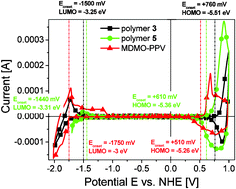Photovoltaic action of conjugated polymer/fullerene bulk heterojunction solar cells using novel PPE-PPV copolymers†
Abstract
The design of novel

* Corresponding authors
a
Linz Institute for Organic Solar Cells (LIOS), Johannes Kepler University, Altenbergerstr. 69, A-4040 Linz, Austria
E-mail:
harald.hoppe@jku.at
Fax: (+43)-732-2468-8770
Tel: (+43)-732-2468-8854
b
Institut für Organische Chemie und Makromolekulare Chemie, Friedrich-Schiller-Universität, Humboldtstr. 10, D-07743 Jena, Germany
E-mail:
c5ayda@uni-jena.de
Fax: (+49)-3641-948202
Tel: (+49)-3641-948267
c Konarka Austria, Altenbergerstr. 69, A-4040 Linz, Austria
The design of novel

 Please wait while we load your content...
Something went wrong. Try again?
Please wait while we load your content...
Something went wrong. Try again?
H. Hoppe, D. A. M. Egbe, D. Mühlbacher and N. S. Sariciftci, J. Mater. Chem., 2004, 14, 3462 DOI: 10.1039/B407794F
To request permission to reproduce material from this article, please go to the Copyright Clearance Center request page.
If you are an author contributing to an RSC publication, you do not need to request permission provided correct acknowledgement is given.
If you are the author of this article, you do not need to request permission to reproduce figures and diagrams provided correct acknowledgement is given. If you want to reproduce the whole article in a third-party publication (excluding your thesis/dissertation for which permission is not required) please go to the Copyright Clearance Center request page.
Read more about how to correctly acknowledge RSC content.
 Fetching data from CrossRef.
Fetching data from CrossRef.
This may take some time to load.
Loading related content
